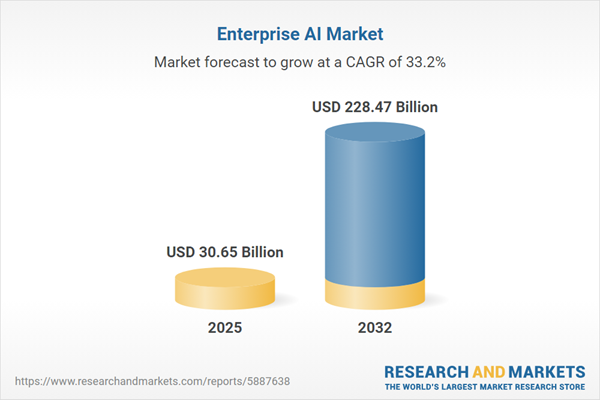Speak directly to the analyst to clarify any post sales queries you may have.
Enterprise AI is rapidly reshaping how organizations operate, offering reliable automation, bolstering compliance, and empowering leaders to make sound data-driven decisions. As the demand for smarter, tech-enabled strategies accelerates, enterprise AI has moved to the center of executive agendas, providing essential tools for future-ready business models.
Market Snapshot: Enterprise AI Market Outlook
The enterprise AI market is undergoing notable expansion, valued at USD 23.05 billion in 2024, with projections of USD 30.65 billion in 2025 and a strong growth trajectory toward USD 228.47 billion by 2032. This growth is supported by a robust 33.19% compound annual growth rate.
Rapid developments in cloud and edge computing, as well as cross-industry collaboration among leading technology vendors, are propelling this trend. Executive teams are advancing AI adoption to solve unique compliance challenges, devise agile operating models, and build frameworks for long-term innovation. Staying ahead in this dynamic market requires decisive action, cohesive technology integration, and clear differentiation, all of which drive both heightened competition and new opportunities for forward-thinking businesses.Scope & Segmentation of the Enterprise AI Market
This report offers a strategic overview of the enterprise AI market, detailing critical factors that shape enterprise technology decisions and investment strategies:
- Organization Size: Large enterprises and mid-sized firms structure their AI integration in line with their scale, available resources, and specific business growth targets.
- Deployment Mode: Enterprises select cloud, hybrid, or on-premises solutions to align with privacy demands, infrastructure readiness, and local regulatory frameworks.
- Component: Comprehensive AI systems leverage specialized hardware, modular software, and professional services to maximize seamless deployment and long-term performance.
- Industry Vertical: Industries such as finance, healthcare, public sector, telecom, manufacturing, and retail prioritize AI based on regulatory requirements and operational needs unique to their fields.
- Application: Critical AI applications include conversational AI for customer interaction, process automation, predictive maintenance for reducing downtime, and advanced analytics supporting effective risk management and executive decision-making.
- Geographic Regions: The Americas, EMEA, and Asia-Pacific demonstrate varying AI adoption trends shaped by regulatory landscapes and tech-readiness in major economies like the U.S., Germany, China, and India.
- Key Technology Providers: Evaluation covers Microsoft, AWS, IBM, Google, NVIDIA, Oracle, Salesforce, SAP, Adobe, and Cisco Systems for their relevant strengths in scalability, security, and regulatory compliance.
Key Takeaways for Senior Decision-Makers
- Strategic enterprise AI implementation boosts agility by automating manual tasks, creating more responsive operating models across business units.
- Deploying digital twin solutions and conversational AI grants deeper comprehension of real-time processes and enhances customer engagement.
- Partnering with compliance teams from the outset fosters preparedness for regulatory changes and streamlines global expansion or cross-border operations.
- Evaluating potential technology vendors should center on the strength of their security protocols and capacity for seamless regulatory integration.
- Adopting modular architectures facilitates scalable growth while limiting business risk, as organizations remain adaptable to evolving policy landscapes.
- Industry-specific AI solutions enable sectors like finance and healthcare to address complex oversight and maintain compliance with specialized standards.
Tariff Impact: Navigating New Trade Dynamics
Shifts in tariffs affecting semiconductor and AI hardware supply chains require organizations to reassess procurement methods and strengthen supply chain resilience. There is a greater emphasis on distributed and software-based architectures for maintaining operational flexibility, thus reducing reliance on single-source hardware providers. High-touch engagement with regulatory agencies, especially for public sector contracts, supports risk mitigation against trade disruptions and helps ensure ongoing business operations remain stable under changing trade conditions.
Methodology & Data Sources
The insights in this analysis are founded on executive interviews, broad-based secondary research, and a detailed review of evolving global regulations influencing the enterprise AI sector. Validation by domain experts guarantees that strategic findings are founded on accurate, relevant intelligence for senior leadership.
Why This Report Matters
- Equips leaders to integrate and scale enterprise AI solutions while effectively managing compliance and organizational risks.
- Supports alignment of business objectives with evolving technology strategies as global standards and operational best practices shift.
- Enables well-informed selection of partners and architectures for diverse regulatory and regional scenarios, supporting strategy resilience.
Conclusion
This report provides essential guidance for executives to navigate the enterprise AI landscape, supporting compliant adoption and strategic vendor partnerships suited to fast-evolving business requirements.
Additional Product Information:
- Purchase of this report includes 1 year online access with quarterly updates.
- This report can be updated on request. Please contact our Customer Experience team using the Ask a Question widget on our website.
Table of Contents
3. Executive Summary
4. Market Overview
7. Cumulative Impact of Artificial Intelligence 2025
Companies Mentioned
The companies profiled in this Enterprise AI market report include:- Microsoft Corporation
- Amazon Web Services, Inc.
- International Business Machines Corporation
- Google LLC
- NVIDIA Corporation
- Oracle Corporation
- Salesforce, Inc.
- SAP SE
- Adobe Inc.
- Cisco Systems, Inc.
Table Information
| Report Attribute | Details |
|---|---|
| No. of Pages | 181 |
| Published | October 2025 |
| Forecast Period | 2025 - 2032 |
| Estimated Market Value ( USD | $ 30.65 Billion |
| Forecasted Market Value ( USD | $ 228.47 Billion |
| Compound Annual Growth Rate | 33.1% |
| Regions Covered | Global |
| No. of Companies Mentioned | 11 |









